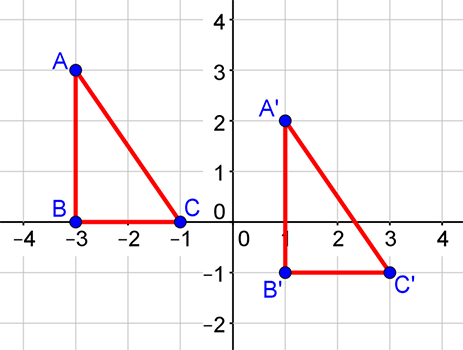Try It
Translations Practice
Practice Problem #1
Determine the number of units a figure would be translated left, right, up, or down.
(x, y) → (x − 4, y + 1)
- The figure will be translated ___blank units ___blank (left or right).
- The figure will be translated ___blank units ___blank (up or down).
Look at the numbers after the x and y parts of the notation. Left/Right as well as Up/Down will be determine by whether you have a plus or a minus.
Answer:
- The figure will be translated 4 units left.
- The figure will be translated 1 unit up.
Practice Problem #2
Determine the number of units a figure would be translated left, right, up, or down.
(x, y) → (x + 8, y + 4)
- The figure will be translated ___blank units ___blank (left or right).
- The figure will be translated ___blank units ___blank (up or down).
Look at the numbers after the x and y parts of the notation. Left/Right as well as Up/Down will be determine by whether you have a plus or a minus.
Answer:
- The figure will be translated 8 units right.
- The figure will be translated 4 units up.
Practice Problem #3
Determine the number of units a figure would be translated left, right, up, or down.
(x, y) → (x − 6, y)
- The figure will be translated ___blank units ___blank (left or right).
- The figure will be translated ___blank units ___blank (up or down).
Look at the numbers after the x and y parts of the notation. Left/Right as well as Up/Down will be determine by whether you have a plus or a minus.
Answer:
- The figure will be translated 6 units left.
- The figure will be translated 0 units up/down.
Practice Problem #4
Determine the new coordinates of each point.
(x, y) → (x + 4, y − 1)

- A (−3, 3) → A'(___blank, ___blank)
- B (−3, 0) → B'(___blank, ___blank)
- C (−1, 0) → C'(___blank, ___blank)
Answers:
- A (−3, 3) → A'(1, 2)
- B (−3, 0) → B'(1, −1)
- C (−1, 0) → C'(3, −1)
Practice Problem #5
Which of the following is the transformation shown?
none of these
reflection across the x-axis
rotation by 90° clockwise
translation
Answer: translation